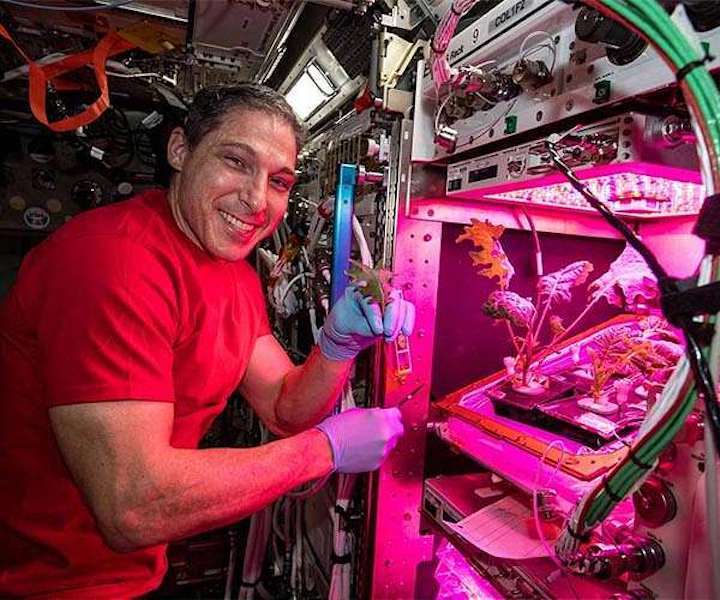8.03.2021

NASA astronaut Mike Hopkins has tended to multiple plant experiments on the International Space Station (ISS). Hopkins believes plants grown in space can help astronauts become more self-sufficient.
NASA astronaut Mike Hopkins' enthusiasm for learning to grow plants in space has proven fruitful for the agency's Vegetable Production System (Veggie).
The Expedition 64 crew member, who arrived at the International Space Station in November 2020 aboard NASA's SpaceX Crew-1 for a six-month science mission, has tended to multiple plant experiments on station. Astronaut Kate Rubins had already started growing the first of two crops of radishes in the Advanced Plant Habitat when Crew-1 arrived, and Hopkins quickly started assisting with the radishes. He harvested the second crop on Dec. 31, and the space station's crew were able to eat the freshly harvested radishes.
On Jan. 4, Hopkins initiated two experiments, VEG-03I, which involved the first successful plant transplants in space, and VEG-03J, which featured the use of new seed film developed at NASA's Kennedy Space Center in Florida. The seed film allowed him to plant lettuce in orbit instead of the prior method of having researchers on the ground plant the crops prior to their delivery to orbit. He harvested both experiments on Feb. 2.
Less than a week later, Hopkins began growing VEG-03K and VEG-03L, testing a new space crop, 'Amara' mustard - nicknamed "steak plant" by researchers at Kennedy because of its taste - and a previously grown crop "Extra Dwarf" pak choi.
Hopkins, the commander of Crew-1, which included fellow NASA astronauts Victor Glover and Shannon Walker, along with Japanese Aerospace Exploration Agency (JAXA) astronaut Soichi Noguchi, highlighted two reasons - among his list of many - why these experiments are important for human spaceflight.
"First, plants grown in space provide a food source that could enhance astronaut nutrition while making future crews more self-sufficient," Hopkins said. "Second, these plants are a connection to Earth. The look, feel, taste, and smell all remind us of life on Earth, and that connection is good for our mental health."
At Kennedy, Ralph Fritsche, senior project manager for space production, and Matt Romeyn, a space crop production project scientist and science lead on the four plant experiments, are receiving updates about every other day from Hopkins and his crew. This regular contact has played a huge role in the experiments' success.
"It's everything in growing plants," Romeyn said of the timely astronaut updates. "We've had so much contact, I almost feel like I'm there sometimes."
The regular resupplies that the space station receives, along with instantaneous communications, won't be possible when NASA embarks on long-duration human spaceflight, such as missions to Mars. Currently, astronauts primarily eat a pre-packaged diet that has proven nutritious enough to support people for 20 years on station. However, human exploration of the Moon and Mars will require new solutions as people push the boundaries of exploration.
"Pre-packaged food right now has a good shelf life for about 18 months. Even if that diet is extended, there is the psychological component of having fresh food, as well as the interaction with the plants," Fritsche said. "When I look at a system to take to Mars, or to have and deploy on the Moon, this is the kind of thing we want to get to - that capability to continuously supply crops for food."
Hopkins knows the research he is conducting on station now could have a significant impact on future space travelers.
"Even though astronauts can't run to the supermarket for fresh produce during a two-year mission to Mars, they could float into a module that has the same smell and feel of the produce section," Hopkins said. "And that will put a smile on any astronaut's face, making them more effective during their primary mission activities."
Deep Space Food Challenge
While Frische, Romeyn, and other experts are researching solutions, they only represent a small portion of the creativity and expertise available. NASA and the Canadian Space Agency have coordinated their efforts to seek crowd-sourced solutions to feeding astronauts in the future.
The Deep Space Food Challenge is a multi-phased international competition to develop innovative and sustainable food systems for long-duration human exploration missions. Interested participants from the United States can compete for part of a prize purse of up to $500,000 from NASA in Phase 1 of the competition by designing food systems that can provide adequate nutrition for future long-duration mission explorers.
Depending on the technologies presented, a possible second phase, involving a kitchen demonstration, could follow. Click here for more information about how to participate to the challenge.
Quelle: SD
